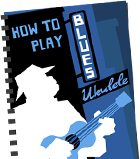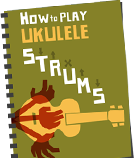Jake Shimabukuro and his haircut appear on Conan O’Brien. Is Conan gargantuan or is Jake the size of an Action Man?
The Paris Uke Fest will be taking place on the 30th and 31st May. The lineup includes Victoria Vox and Michael Wagner.
You already know that weePop! is my favourite record label, but now they’ve become my even favouriter. They’ve got new releases from Jacob Borshard and One Happy Island. I’m sure you’ve already downloaded and fallen in love with Jacob Borshard’s two albums. You can check out a track from One Happy Island on Logical Logic.
An excellent piece on the ukulele in The Guardian. Which is what you’d expect as it’s written by Rock That Uke director William Preston Robertson. “Yes, there are other instruments with greater range, but none that can exist so innocently, so vulnerably, so fearlessly and precisely in that duality of time and space that is both joy and sorrow as can the ukulele.”
New chords on Uker Tabs including Fields of Gold, Theme from Fall Guy and Uptown Top Ranking. Thanks to zymeck and exoticorn for their efforts. Go here if you want to upload your own.
The Kaiser Chiefs’ Ricky Wilson plays the ukulele to Paul McCartney at the Brit Awards.
More from Trixie Tangway the ukulele sweetheart (a.k.a. Kristen Schaal off of Flight of the Conchords). She even picks up a ukulele this time.
Can you guess what the hell Shaun Keaveny off of BBC 6 Music’s Breakfast Show is playing on his flying V ukulele? Beats me.
Judging by recent reviews, ukulele tracks crop up on forthcoming albums by Van Morrison and, rather unexpectedly, Portishead.
iWantUkeTunes. I stumbled upon this this site today and I’m not quite sure what to make of this site yet. It lets you search for free ukulele mp3s, but it seems to spit out the same few songs whatever you search for. I’m guessing it’s in early stages of development. My advice: do a blank search and pick up any mp3s that take your fancy.
I’ve been working my way through the archives of Amoeba Music’s in-store perfomances. There are some rollockingly good videos (and there’s a live webcast with Kimya Dawson tonight). On the uke front, they have Uni and Her Ukulele.
Message from Stephin Merritt: Don’t play the ukulele, it’s too dangerous.
Uke Hunt is worth $27,662.46. That seems fantastically unlikely.










